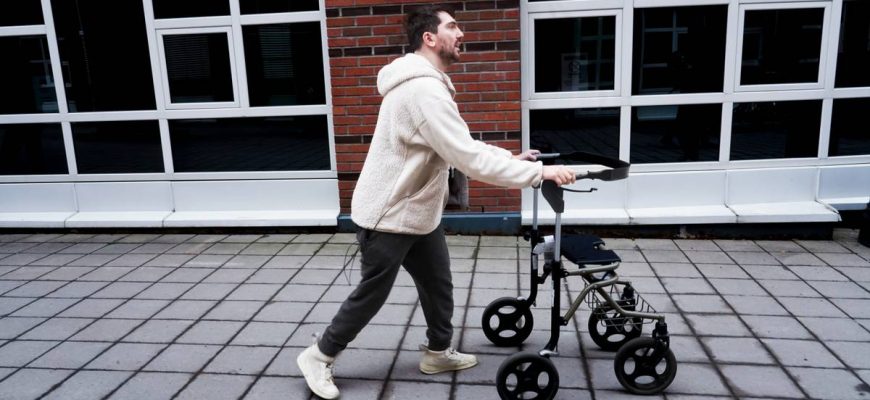Amir Hashani stands outside the physiotherapist.
Because he has cerebral palsy, he is dependent on a wheelchair and walker.
He cannot drive himself, and therefore he needs to Patient travel drives him where he needs to go.
But often he stands and waits. If the taxi comes at all, it will be late.
– Does it happen that Patient Travel comes in time?
– Not often. But every now and then, on a good day, Hashani says dejectedly.
On a good day, it happens that Patient Travel arrives on time. But that’s not often, says Hashani.
Photo: Nadir Alam / NRK
Last week the car was over an hour late, and Hashani called four times to find out where it was.
He spends a lot of time sitting and waiting.
– Very, very, very much. I am often late. Then there is not much time with the physiotherapist and we have to hurry.
– As if their time is less valuable
– It happens at least weekly that patients arrive here late due to Patient Travel, says physiotherapist Kristin Bakkeli.
She is disappointed and thinks there must be a better way to organize it.
The Norwegian Physiotherapist Association has complained to Pasiontreiser many times, but says they do not notice any improvement.
TREATMENT: Physiotherapists Kristin Bakkelig and Amir Hashani will meet three times a week for treatment. It is not always that they get the treatment they are supposed to, because of Patient Travel.
Photo: Nadir Mohammad Alam / NRK
– It’s as if people believe that their time is less valuable, says Bakkeli and points to Hashani.
It is frustrating for the patient, but also for the doctors, therapists and other healthcare professionals who spend valuable time waiting for patients who never arrive.
– You simply have to sit and wait an awful lot if you use Patient Travel.
Received 3,000 non-conformity notices
– There are too many deviations and it is serious, says Karl Haakon Sævold, county leader of Norway’s Handikapforbund Oslo.
He emphasizes that this has major consequences for the patients who are dependent on appointments with doctors, physiotherapists and other health services.
In three months, they have received over 3,000 reports of discrepancies at Pasiontreiser.
– We are contacted by members who say that when they are waiting for patient transport they are anxious, get a lump in their stomach and do not know if they will arrive in time.
These are people who are dependent on Pasiontreiser working, emphasizes Sævold.
– But there are also long-term effects, because the medical treatment they need is crucial for them. So if they miss classes, yes, there are also consequences in everyday life for the individual.
Together with the Physioterapeutforbundet, the Handikapforbundet has now sent a letter to the Health Corporation and the Health City Council demanding that this be cleared up.
– Everyone who works with patient travel must get together and make this transport work.
– Something must be done to fix this, says the county leader of the Norwegian Association for the Disabled Oslo, Karl Haakon Sævold.
Photo: Rolf Petter Olaisen / NRK
Gets complaints from all over the country
There are no national figures for how many non-conformity notices Pasiontreiser receives. But Kristian Lian, interest policy adviser in Norway’s Handikapforbund, says the problem is nationwide.
– There is a lot of frustration over long waiting times. It is exhausting and tiring for the patients who have to wait so long. We hear that from our members all over the country, says Lian.
Especially for the patients who have treatment several times a week, it eats away with regular delays, he believes.
– We fear that patients will drop out of treatment because they cannot bear to wait for Patient Travel. It is critical.
– Do you think it will happen?
– Yes, I think that will happen, says Lian clearly.
He is disappointed that Pasiontreiser has not done the job of collecting national figures on how many deviations they themselves have.
– It is both strange and weak that they do not have an overview of it, he believes.
I think most people have a good offer
– We have many trips every day. The 3,000 deviations are part of 230,000 completed assignments, says Egil Johannessen, head of department for patient travel and patient transport at Oslo University Hospital.
So it is approx. He calculates that 1.3% of assignments have deviations.
He also says that when you look at average waiting time after treatment in Oslo last year, it was 16 minutes.
MOSTLY IT GOES WELL: There are only 1.3% of journeys where there are deviations, says Egil Johannessen, department manager for Patient Travel and Patient Transport at Oslo University Hospital.
Photo: Hallgeir Braastad / NRK
He points to a particular winter with a lot of bad weather and traffic problems as the reason for most of the deviations, and says that usually they have far fewer deviations.
But there is one area he admits they have struggled with for several years.
– These are the transports where the patient has to sit in a wheelchair during transport, where we need minibuses. There are simply problems with access to the market.
Never know if he’ll make it
The many delays make everyday life extra difficult for Amir Hashani.
He never knows if he will arrive in time, get the treatment he should have or just have to stay home.
– No, I’m never sure of that, he says.
PENDING: Position known for Amir Hashani
Photo: Nadir Mohammad Alam / NRK
Published
17.04.2024, at 23.12








